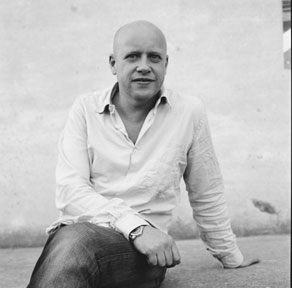27th>29th september 2007
Arezzo, Villa Severi
Marginality as situation in which runs into who breaks social rules and steady and inviolable behavioural codes within a community, but also as condition opposed to that of centrality, dialectic pole of definition of a changing territory. Jens Haaning handles right from the beginning of his work these social dynamics which have also become the starting point of the workshop which he held in the city of Arezzo with the young artists of Networking 2007. How to set a workshop held by Jens Haaning? Easy. A clock with a timer which marks the expiration of each working hour is enough. The artist needed only this to start the work. The timer, which marked the expiration of each working hour, abruptly interrupted the discussion. The flow of time and the draw to the physical aspect of the actual situation broke on the boards drifting and continually re-setting up the discussion.
The first commitment of the workshop for the partakers has been having to look in the city for an example of “printed matter” which in some way could represent clues of the territory around Arezzo and of how this is lived by its inhabitants and to take it back to the meeting place (for “printed matters” it was meant printouts coming from newspaper pages, magazines, books or posters). Each artist collected the most varied stuff: flyers, sheets of prayers, ads, newspapers…each of which was to them meaningful for a particular reality of the city, told a meaningful aspect of how the city is imagined and described.
The rhythm was being beated by the hour and minute hands and by the timer while a long coversation was being carried out about the conditions of centrality and marginality present in the city of Arezzo and, more in general, about the dynamics which in the contemporariness make up such conditions within a territory. What are the urban and social elements which can define a social space? In what way these latter are conveyed to people and felt by them? Which are the conditions of social exclusion in which a person realizes that he/she belongs to a marginal context? What makes up marginality in a global context?
A place where at the same time the idea of centrality and that of marginality face one another has beem recognized in the church because it is a spot which welcomes a specific community of people, who, confident in their own religious identity, has the tendence to assume an inclusive and an exclusive social role at the same time. From the purpose of reconsidering these relationships Cathedring was borne, which is an edible reproduction of the Cathedral of Arezzo. During the public opening of the workshop it represented a particular moment of aggregation. |
The aggregation power of the church of Arezzo is here summerized and, somehow, reconsidered in a work which remains open to many levels of reading.
The same semantic complexity can be found in the other works realized during the workshop, as if, in these cases as in Haaning’s work itself, the role of artistic practices becomes visible in the ability to provoke complex questions rather than prescribe solutions. Solutions, moreover, complex like the ones of the project Architectural proposals for Arezzo, where Arezzo’s landscape pictured on plain postcards is reinterpreted through the cut and removal of the meaningful monuments. Opposite to Cathedring where the artwork is first built through the buildup and is then slowly deconstructed , here the process is subtraction. The city, missing its most important monuments which establish its position of importance in an historical-artisitc hierachy, becomes unknowable but, on the other hand, ready to re-think itself the whole hog. The fetish postcard has this time as its focus the “secondary” buildings of the city.
For someone else instead, Arezzo’s outskirts evoke other outskirts which exist in other places. It is the project Mirage (Ucraina), in which the homonym writing is projected on the sweet tuscan hills in front of Villa Severi, headquarters of the workshop. Umpteenth version of the famous writing on Hollywood’s hills and of its version in Sicily, this time though, inverting the paradigm of a dream close by no means.
A project which reflects on the same media geographies is I’m an Italian artist, attained laying labels with the writing “I’m an Italian artist and I’m very happy of living in Berlin. In Berlin I currently live near a church” on plastic dishes and glasses used for the buffet. The opening became, like this, an instrument through which being able to share with the participants the choice of a tuscan artist who decided to move in Berlin.
Sign road ethics , is a project for an urban installation in which, near a bend on the internal white stripe of the roadway, the writing “Live to the limit” is put. An intervention which has at the same time a positive meaning, if one looks at it from the internal side of the road stripe, but also potentially negative. The social rules of a community are at the same time means of balance and social integration but also of control.
Scream was instead a performance expressly carried out for the opening in a totally unexpected way for the audience. The audience was knocked down by the crash power of the single words (hate, distruction, love and war) screamed by one of the woman artist taking part to the workshop.
Text published on Tafter.it on 3, December 2007 |






